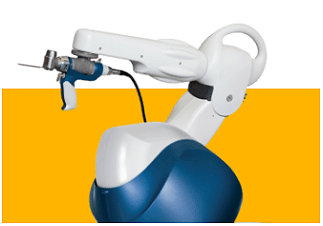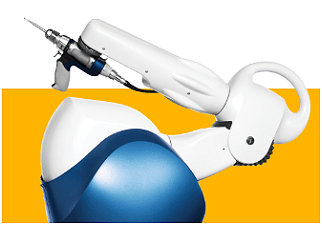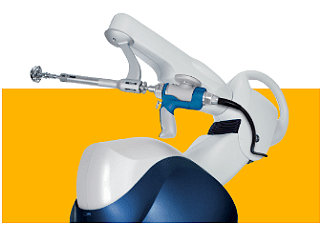Introducing Mako SmartRobotics
Mako SmartRobotics combines three key components: 3D CT-based planning, AccuStop haptic technology, and insightful data analytics, into one platform that has shown better outcomes for your total knee, total hip and partial knee patients. 1,2,3
It all starts with a CT scan that creates a 3D image of your patient’s unique anatomy. This information you’ve never had before allows you to create your patient’s plan and assess and balance the joint.
Mako Total Knee
A distinct, prospective, consecutive series, single-surgeon study comparing patients undergoing conventional jig-based total knee replacement versus Mako Total Knee surgery (40 patients) concluded that Mako Total Knee with Triathlon was associated with: Less need for opiate analgesics (p<0.001), less time to hospital discharge (26% reduction in LOS), less need for in-patient physical therapy sessions (p<0.001), and less postoperative pain (p<0.001).4
Mako Partial Knee
At minimum 3-year follow-up, Mako Partial Knee patients (n=51) showed no implant failure or implant-related complication or revision surgery, as well as excellent overall patient satisfaction for 96.1% of patients (patients reported very satisfied or satisfied).5
Using everything the CT scan helps you to know about your patient, Mako AccuStop haptic technology guides you to cut what’s planned precisely for each patient.1,14,15 For some patients, that means preserving soft tissue; for others, that means saving healthy bone.7,8,9,10
Mako Total Knee
A prospective, consecutive series, single-surgeon study comparing patients undergoing conventional jig-based total knee replacement versus Mako Total Knee surgery (30 patients), concluded that Mako Total Knee with Triathlon was associated with less bone and soft tissue damage (p<0.05).8
Mako Partial Knee
In a single surgeon study comparing consecutive Mako Partial Knee (n=73) vs. manual Oxford uni (n=73), Mako Partial Knee patients demonstrated: reduced post-op pain (p<0.001), decreased analgesia requirements (p<0.001), shorter time to straight leg raise (p<0.001), decreased number of PT sessions (5 vs. 9, p<0.001), improved max knee flexion at discharge (p<0.001), and reduced mean time to hospital discharge (29 hours).11
Mako Total Hip
In a controlled, match-paired study, using acetabular head size as an approximate surrogate measure of acetabular bone resection, results suggested greater preservation of bone stock using Mako Total Hip compared to manual surgery.12

MKOSYM-SS-15_29279
*For the Mako Total Knee application, “cut less” refers to less soft tissue damage and greater bone preservation as compared to manual surgery.8,9 For the Mako Total Hip and Partial Knee applications, “cut less” refers to greater bone preservation as compared to manual surgery.7,10
References:
- Illgen, R, Bukowski, B, Abiola, R, Anderson, P, Chughtai, M, Khlopas, A, Mont, M. Robotic-assisted total hip arthroplasty: Outcomes at minimum two year follow up. Surgical Technology International. 2017 July 25; 30:365-372.
- Kayani B, Konan S, Tahmassebi J, Pietrzak JRT, Haddad FS. Robotic-arm assisted total knee arthroplasty is associated with improved early functional recovery and reduced time to hospital discharge compared with conventional jig-based total knee arthroplasty: a prospective cohort study. The Bone and Joint Journal. 2018;100-B:930-7.
- Kleeblad LJ, Borus T, Coon T, Dounchis J, Nguyen J, Pearle A. Midterm survivorship and patient satisfaction of robotic-arm assisted medial unicompartmental knee arthroplasty: a multicenter study. The Journal of Arthroplasty. 2018:1-8.
- Haddad, F.S., et al. Robotic-arm assisted total knee arthroplasty is associated with improved early functional recovery and reduced time to hospital discharge compared with conventional jig-based total knee arthroplasty. The Bone & Joint Journal, July 2018.
- Dretakis, K, Igoumenou, VG. Outcomes of robotic-arm assisted medial unicompartmental knee arthroplasty: minimum 3-year follow-up. European Journal of Orthopaedic Surgery & Traumatology. 2019 Aug;29(6):1305-1311.
- Nawabi D, Conditt M, Ranawat A, Dunbar N, Jones J, Banks S, Padgett D. Haptically guided robotic technology in total hip arthroplasty: A cadaveric investigation. Proc Inst Mech Eng H. 2013 Mar;227(3):302-9.
- Suarez-Ahedo, C; Gui, C; Martin, T; Chandrasekaran, S; Domb, B. Robotic arm assisted total hip arthoplasty results in smaller acetabular cup size in relation to the femoral head size: A Matched-Pair Controlled Study. Hip Int. 2017; 27 (2): 147-152.
- Haddad, F.S, et al. Iatrogenic Bone and Soft Tissue Trauma in Robotic-Arm Assisted Total Knee Arthroplasty Compared With Conventional Jig-Based Total Knee Arthroplasty: A Prospective Cohort Study and Validation of a New Classification System. J Arthroplasty. 2018 Aug;33(8):2496-2501. Epub 2018 Mar 27.
- Hozack, W, Chen, A, Khlopas, A, Mahoney, O, Mont, M, Murray, T, Orozco, F, Higuera Rueda, C, Stearns, K. Multicenter Analysis of Outcomes after Robotic-Arm Assisted Total Knee Arthroplasty. American Academy of Orthopedic Surgeons Annual Meeting. Las Vegas, NV. March 12-16, 2019.
- Hampp E, Chang TC, Pearle A. Robotic partial knee arthroplasty demonstrated greater bone preservation compared to robotic total knee arthroplasty. Annual Orthopaedic Research Society. Austin, TX. 2-5 Feb 2019.
- Kayani B, Konan S, Tahmassebi J, Rowan FE, Haddad FS. An assessment of early functional rehabilitation and hospital discharge in conventional versus robotic-arm assisted unicompartmental knee arthroplasty. Bone Joint J. 2019 Jan;101-B(1):24-33.
- Suarez-Ahedo C, Gui C, Martin T, Chandrasekaran S, Lodhia P, Domb B. Robotic-arm assisted total hip arthroplasty results in smaller acetabular cup size in relation to the femoral head size: a matched-pair controlled study. Hip Int. 2017; 27 (2): 147-152.
- Stryker’s sales and case data
- Anthony I, Bell SW, Blyth M, Jones B et al. Improved accuracy of component positioning with robotic-assisted unicompartmental knee arthroplasty. J Bone Joint Surg Am. 2016;98-A(8):627-35.
- Mahoney O, Kinsey T, Mont M, Hozack W, Orozco F, Chen A. Can computer generated 3D bone models improve the accuracy of total knee component placement compared to manual instrumentation: a prospective multi-center evaluation? International Society for Technology in Arthroplasty 32nd Annual Congress. Toronto, Canada. October 2-5, 2019.
MKOSYM-WC-23_23838




